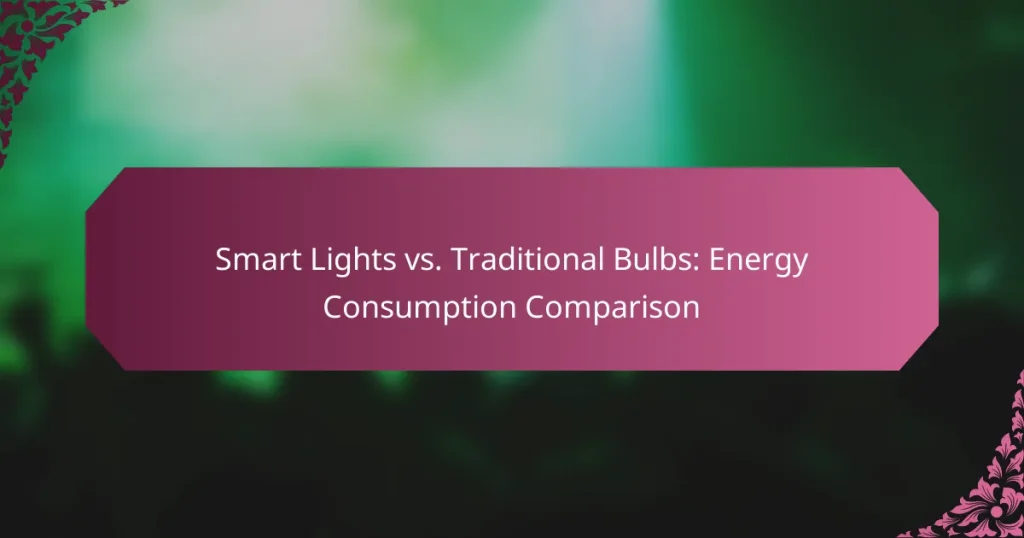
Smart Lights vs. Traditional Bulbs: Energy Consumption Comparison
As energy efficiency becomes increasingly important, the comparison between smart lights and traditional bulbs reveals…
Smart home devices have revolutionized the way we interact with our living spaces, offering enhanced convenience, security, and energy efficiency. From video doorbells to smart locks, these technologies provide real-time monitoring and automation that simplify daily tasks. In this ultimate guide, we will explore the best devices available, how to choose the right ones for your needs, and the benefits they bring to your home.

As energy efficiency becomes increasingly important, the comparison between smart lights and traditional bulbs reveals significant differences in energy consumption. Smart lights typically use less energy while offering advanced features and remote control capabilities, making them a more efficient and convenient choice for modern households. By understanding the factors that influence energy usage, consumers can…
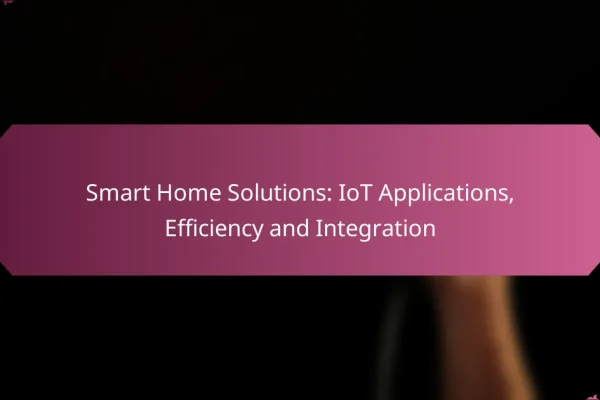
Smart home solutions leverage IoT applications to enhance energy efficiency, convenience, and security within the home. By integrating devices such as smart thermostats and lighting systems, homeowners can optimize energy usage and reduce utility costs while enjoying seamless control over their living environment. This technology not only simplifies daily tasks but also contributes to a…
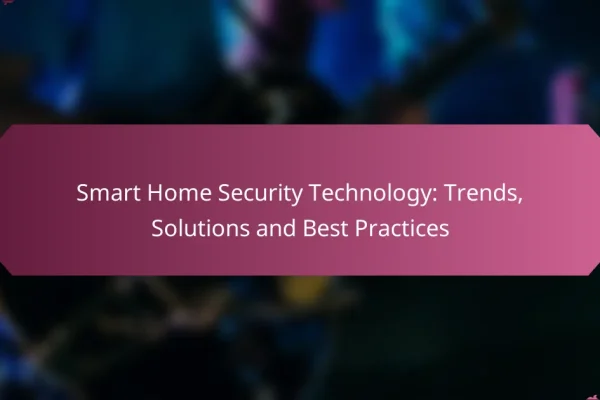
Smart home security technology is rapidly evolving, offering innovative solutions that enhance safety and monitoring for homeowners. From video doorbells to smart locks, these systems integrate various devices to provide real-time updates and alerts, ensuring comprehensive protection. The latest trends emphasize advanced features like AI and biometric authentication, empowering users with greater control and peace…
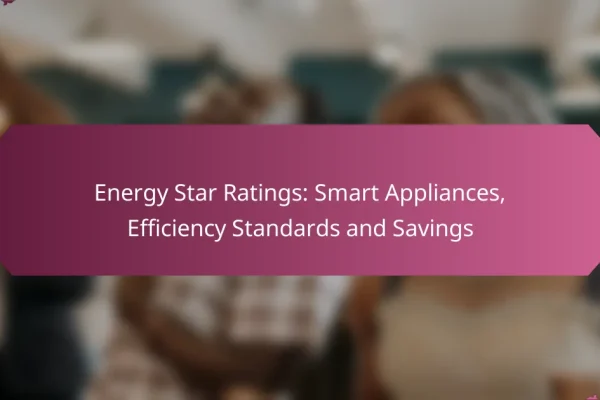
Energy Star ratings play a crucial role in identifying smart appliances that meet stringent energy efficiency standards set by the U.S. Environmental Protection Agency. By choosing Energy Star certified products, consumers can enjoy lower energy bills, contribute to environmental sustainability, and potentially enhance the value of their homes. How do Energy Star ratings impact smart…
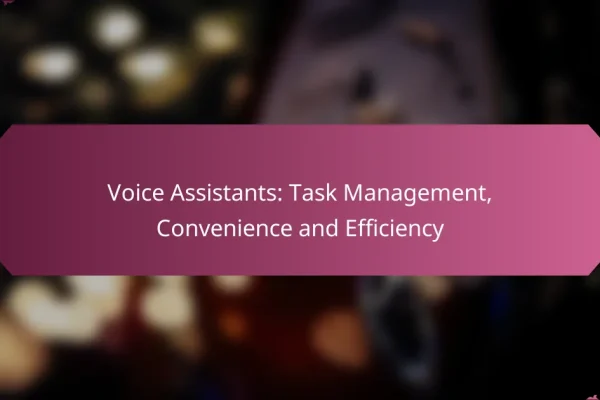
Voice assistants have revolutionized task management by allowing users to execute commands and organize their activities through simple voice interactions. This hands-free convenience not only enhances efficiency but also enables individuals to prioritize their tasks while automating routine functions, ultimately streamlining daily life. How do voice assistants improve task management? Voice assistants enhance task management…
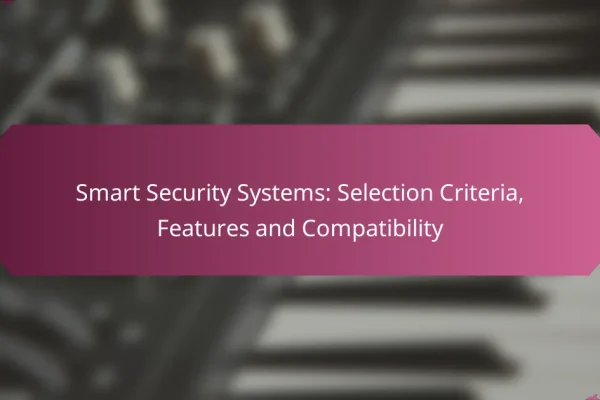
Smart security systems are essential for modern home protection, offering advanced technology and user-friendly interfaces. When selecting a system, it’s important to evaluate your specific security needs, compatibility with existing devices, and installation options to ensure optimal effectiveness. Key features such as real-time alerts, remote access, and video surveillance enhance security while integrating seamlessly into…

Smart home systems offer convenience and efficiency, but understanding the total cost of ownership is crucial for homeowners. This includes not only the initial purchase and installation costs but also ongoing operational expenses and potential savings from enhanced energy efficiency. Regular maintenance, such as software updates and hardware inspections, is essential to ensure these systems…
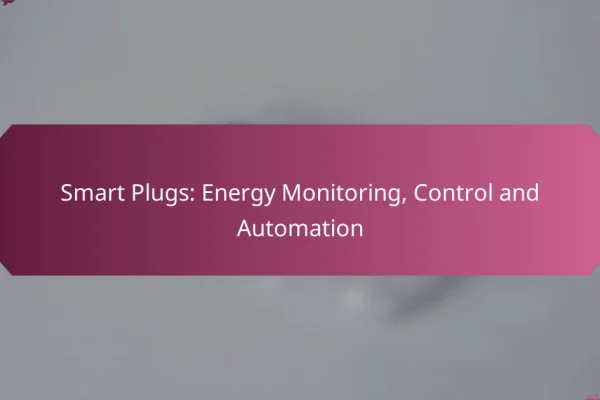
Smart plugs are innovative devices that enable users to monitor and control their energy consumption effectively. By providing real-time data and historical insights, these plugs help track electricity usage and automate home appliances, enhancing convenience and promoting energy savings. With mobile app integration and scheduling capabilities, smart plugs optimize energy management for a more efficient…

Smart home devices play a crucial role in reducing carbon footprints and promoting sustainability by optimizing energy consumption and enhancing efficiency. By automating energy management, these technologies not only lower greenhouse gas emissions but also help homeowners save on utility bills, making eco-friendly living more accessible and affordable. How can smart home devices reduce carbon…

Smart home apps are essential tools that blend intuitive design with functional usability, enabling users to manage their devices with ease. A well-crafted interface enhances navigation and customization, while key features such as device compatibility, automation, and security ensure a seamless and efficient experience. By prioritizing usability, these apps significantly improve user satisfaction and engagement…
The best smart home devices for security include video doorbells, security cameras, smart locks, and comprehensive home security systems. These devices enhance safety by providing real-time monitoring, remote access, and automated alerts.
The Ring Video Doorbell allows homeowners to see and communicate with visitors at their door through a smartphone app. It features HD video, two-way audio, and motion detection alerts, making it a practical choice for monitoring entry points.
When installing, ensure the doorbell is within Wi-Fi range for optimal performance. Consider the subscription plan for cloud video storage, which can enhance functionality by allowing you to review footage later.
The Arlo Pro 4 Security Camera offers high-definition video quality and advanced features like night vision and a built-in spotlight. It is wireless, making installation straightforward, and can be integrated with other smart home devices.
Evaluate the camera's field of view and battery life to ensure it meets your coverage needs. Subscriptions can provide additional features, such as cloud storage and advanced AI detection, which may be beneficial for comprehensive security.
The August Smart Lock allows you to control access to your home without traditional keys. It can be locked or unlocked remotely via a smartphone app, and it supports keyless entry for guests, enhancing convenience and security.
Installation is simple, as it fits over existing deadbolts, preserving your original hardware. Be mindful of battery life, and consider setting up alerts for when the lock is accessed to stay informed about who enters your home.
SimpliSafe provides a complete home security solution with customizable packages that include sensors, cameras, and monitoring services. It is known for its easy installation and no-contract options, making it accessible for various budgets.
Choose components based on your specific security needs, such as door/window sensors or indoor/outdoor cameras. Regularly test the system and update your monitoring preferences to ensure optimal protection against intrusions.
Choosing the right smart home devices involves assessing compatibility, user feedback, and installation needs. Prioritize devices that seamlessly integrate with your existing systems and have positive reviews to ensure a smooth experience.
Compatibility is crucial when selecting smart home devices. Ensure that the devices you choose can connect with your current ecosystem, whether it’s a specific smart hub, voice assistant, or home automation platform. For instance, if you use Amazon Alexa, look for devices that explicitly state compatibility with Alexa.
Check for compatibility with protocols like Zigbee, Z-Wave, or Wi-Fi. Devices that support multiple protocols can offer greater flexibility and integration options, allowing you to expand your smart home setup more easily.
User reviews and ratings provide valuable insights into the performance and reliability of smart home devices. Look for products with high ratings and read through both positive and negative reviews to get a balanced view. Pay attention to comments about ease of use, reliability, and customer support experiences.
Consider the number of reviews as well; a product with a high rating but only a few reviews may not be as trustworthy as one with a solid rating from a larger user base. Websites like Amazon, Best Buy, and dedicated tech review sites can be excellent resources for gathering this information.
Installation requirements can vary significantly between smart home devices. Some devices are designed for easy DIY installation, while others may require professional help, especially if they involve electrical work or complex setups. Always check the installation instructions before purchasing to ensure you are comfortable with the process.
Consider whether the device requires additional hardware or software to function properly. For example, some smart security cameras may need a specific hub or app to operate. Understanding these requirements upfront can save you time and frustration during setup.
Smart home devices offer numerous advantages, including improved convenience, enhanced security, and increased energy efficiency. These benefits can significantly simplify daily tasks, protect your home, and reduce utility costs.
Smart home devices streamline daily activities by automating routine tasks. For instance, smart speakers can control lighting, music, and temperature with simple voice commands, allowing for hands-free operation.
Additionally, smart devices can be programmed to follow schedules. For example, you can set your thermostat to adjust temperatures automatically based on your daily routine, ensuring comfort when you’re home and saving energy when you’re away.
Smart home devices significantly improve home security through features like remote monitoring and alerts. Smart cameras and doorbells allow homeowners to view live feeds and receive notifications on their smartphones when motion is detected.
Many systems also integrate with smart locks, enabling keyless entry and remote locking capabilities. This means you can grant access to guests or service providers without being physically present, enhancing both security and convenience.
Smart home devices contribute to energy efficiency by optimizing energy use. Smart thermostats can learn your habits and adjust heating and cooling settings accordingly, potentially reducing energy bills by 10-20%.
Smart lighting systems can automatically turn off lights when no one is in the room, further conserving energy. By investing in these technologies, homeowners can see significant savings over time while also reducing their environmental footprint.
Smart home devices integrate with voice assistants by using Wi-Fi or Bluetooth connections to communicate commands and receive feedback. This allows users to control various devices, such as lights, thermostats, and security systems, using simple voice commands.
Many smart home devices are designed to be compatible with Amazon Alexa, enabling users to control them through voice commands via Echo devices. To ensure compatibility, look for the "Works with Alexa" label on products, which indicates they can seamlessly integrate with Alexa.
Setting up Alexa-compatible devices typically involves connecting them to the same Wi-Fi network and enabling the corresponding skill in the Alexa app. Once set up, users can issue commands like "Alexa, turn on the living room lights" for easy control.
Google Assistant also supports a wide range of smart home devices, allowing users to manage their home environment using voice commands through Google Nest speakers or smartphones. Look for devices that state "Works with Google Assistant" to ensure they will function properly with the assistant.
To integrate devices with Google Assistant, users need to link them through the Google Home app, which guides them through the setup process. Commands such as "Hey Google, set the thermostat to 72 degrees" can then be used for convenient management.
Apple HomeKit offers a secure way to control smart home devices using Siri on iPhones, iPads, or HomePods. Devices that support HomeKit will have the "Works with Apple HomeKit" label, ensuring compatibility with Apple's ecosystem.
To set up HomeKit devices, users must add them through the Home app, which often involves scanning a HomeKit code. Once configured, users can issue commands like "Hey Siri, turn off the kitchen lights" for hands-free control.
The top smart home ecosystems include Amazon Alexa, Google Home, and Apple HomeKit. Each ecosystem offers unique features, compatibility with various devices, and user experiences, making them suitable for different preferences and needs.
The Amazon Alexa ecosystem is known for its extensive compatibility with a wide range of smart devices, including lights, thermostats, and security systems. Users can control these devices through voice commands using Alexa-enabled devices like Echo speakers.
When considering the Amazon Alexa ecosystem, it's important to note its integration with third-party applications and services. This allows for automation routines, such as turning off lights when you leave home or adjusting the thermostat based on your schedule.
For optimal use, ensure your devices are compatible with Alexa and explore the Alexa app for setting up routines and managing devices efficiently.
The Google Home ecosystem excels in voice recognition and natural language processing, making it user-friendly for those who prefer conversational commands. Google Nest devices, such as speakers and displays, serve as the central hub for controlling smart home devices.
One key advantage of the Google Home ecosystem is its integration with Google services, allowing users to access calendars, reminders, and streaming services seamlessly. This can enhance daily routines and provide personalized information.
To maximize your experience, consider devices that are certified for Google Assistant and explore the Google Home app for managing settings and creating automation routines.
The Apple HomeKit ecosystem is designed for users who prioritize security and privacy. HomeKit-enabled devices can be controlled through the Home app on iOS devices, providing a cohesive experience for Apple users.
HomeKit supports a range of devices, from smart locks to lights, all of which can be controlled via Siri voice commands. The ecosystem emphasizes end-to-end encryption, ensuring that user data remains secure.
For effective use of HomeKit, ensure your devices are HomeKit-compatible and utilize the Home app to set up scenes and automation, such as locking doors at night or adjusting lighting based on time of day.
Smart home devices can be installed using either professional services or do-it-yourself (DIY) methods. Each option has its own advantages and considerations, depending on your technical skills, budget, and the complexity of the devices.
Hiring professional installation services can ensure that your smart home devices are set up correctly and efficiently. This option is particularly beneficial for complex systems, such as home automation hubs or integrated security systems, where proper configuration is crucial for functionality.
When choosing a professional service, consider factors such as cost, which can range from $50 to $150 per hour, and the company’s reputation. Look for reviews and ask for recommendations to find reliable installers in your area.
DIY installation guides are widely available for most smart home devices, making it an accessible option for tech-savvy individuals. Many manufacturers provide step-by-step instructions, video tutorials, and community forums to assist you through the process.
Before starting a DIY installation, ensure you have the necessary tools and a basic understanding of your home’s wiring and network setup. Common pitfalls include neglecting to update device firmware or misconfiguring network settings, which can lead to connectivity issues.